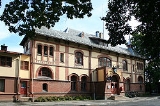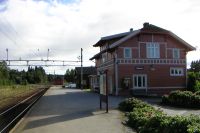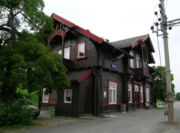
Gjøvikbanen
Encyclopedia
The Gjøvik Line is a Norwegian
railway
line between Oslo
and Gjøvik
. It was originally named the North Line (Nordbanen) and ran between Grefsen
and Røykenvik. The line was completed to Gjøvik
in 1902. The Gjøvik Line was one of the first lines of the Norwegian railway system
which was to be contracted on public service obligation
, but it was the state owned Norges Statsbaner which won it through its subsidiary NSB Anbud.
at .
It serves some of the northern neighborhoods of Oslo, and has a few stations in the woods of Nordmarka
. Further north the line serves the municipality of Nittedal
. At Roa
, the Roa–Hønefoss Line branches off to Hønefoss
, where it continues as the Bergen Line. Formerly, most trains between Oslo and Bergen
used this route, but nowadays most passenger trains run on the route through Drammen
, which is slightly longer but which runs through more densely populated areas. Freight trains however often use the line over Roa. Further north, the Gjøvik Line runs through the district of Toten
before ending at Gjøvik.
Gjøvikbanen formerly had three branch lines, the Røykenvik Line, the Valdres Line and the Skreia Line. All these lines are now closed.
Most of the service on the Gjøvik Line is provided by electric multiple unit
s. The passenger routes are served by the newly (2006) redesigned Type 69D multiple units named Type 69G, rebuilt in Denmark by Danske Statsbaner (DSB).




Norway
Norway , officially the Kingdom of Norway, is a Nordic unitary constitutional monarchy whose territory comprises the western portion of the Scandinavian Peninsula, Jan Mayen, and the Arctic archipelago of Svalbard and Bouvet Island. Norway has a total area of and a population of about 4.9 million...
railway
Rail transport
Rail transport is a means of conveyance of passengers and goods by way of wheeled vehicles running on rail tracks. In contrast to road transport, where vehicles merely run on a prepared surface, rail vehicles are also directionally guided by the tracks they run on...
line between Oslo
Oslo
Oslo is a municipality, as well as the capital and most populous city in Norway. As a municipality , it was established on 1 January 1838. Founded around 1048 by King Harald III of Norway, the city was largely destroyed by fire in 1624. The city was moved under the reign of Denmark–Norway's King...
and Gjøvik
Gjøvik
is a town and a municipality in Oppland county, Norway. The administrative centre of the municipality is the town of Gjøvik.In 1861, the village of Gjøvik in the municipality of Vardal was granted town status and was separated from Vardal to form a separate municipality...
. It was originally named the North Line (Nordbanen) and ran between Grefsen
Grefsen
right|thumbnail|300px|Grefsen ChurchGrefsen is a neighbourhood of the city of Oslo, Norway.Together with Kjelsås, Grefsen was part of the borough Grefsen-Kjelsås until January 1, 2004, when they became part of the new borough of Nordre Aker....
and Røykenvik. The line was completed to Gjøvik
Gjøvik
is a town and a municipality in Oppland county, Norway. The administrative centre of the municipality is the town of Gjøvik.In 1861, the village of Gjøvik in the municipality of Vardal was granted town status and was separated from Vardal to form a separate municipality...
in 1902. The Gjøvik Line was one of the first lines of the Norwegian railway system
Rail transport in Norway
The Norwegian railway system comprises 4,087 km of track of which 2,622 km is electrified and 242 km double track. There are 696 tunnels and 2760 bridges....
which was to be contracted on public service obligation
Public Service Obligation
In transport, public service obligation or PSO is an arrangement in which a governing body or other authority offers an auction for subsidies, permit the winning company a monopoly to operate a specified service of public transport for a specified period of time for the given subsidy...
, but it was the state owned Norges Statsbaner which won it through its subsidiary NSB Anbud.
The line
The lines is the smallest and least trafficked railway line from Oslo, and the only single track line in the capital. Like most other Norwegian railway lines, the entire 124 km long line is electrifiedRailway electrification system
A railway electrification system supplies electrical energy to railway locomotives and multiple units as well as trams so that they can operate without having an on-board prime mover. There are several different electrification systems in use throughout the world...
at .
It serves some of the northern neighborhoods of Oslo, and has a few stations in the woods of Nordmarka
Nordmarka
Nordmarka is the mostly forested region which makes up the northern part of Oslo, Norway. The area called "Nordmarka" also extends into the municipalities of Hole, Ringerike, Lunner, Jevnaker and Nittedal. It is the largest part of the Marka borough. The forests are popular sites for hiking and...
. Further north the line serves the municipality of Nittedal
Nittedal
Nittedal is a municipality in Akershus county, Norway. It is part of the traditional region of Romerike. The administrative centre of the municipality is the village of Rotnes....
. At Roa
Roa, Norway
Roa is the administrative centre of Lunner municipality, Norway. Together with the village Lunner it forms an urban area with a population of 1,576. The railway Gjøvikbanen goes through Roa, with trains stopping at Roa Station.-References:...
, the Roa–Hønefoss Line branches off to Hønefoss
Hønefoss
Hønefoss is a city in Buskerud county, Norway, and the center of the municipality of Ringerike.In 1852, Hønefoss received town status and was separated from Norderhov. Hønefoss celebrated its 150th year of township in 2002...
, where it continues as the Bergen Line. Formerly, most trains between Oslo and Bergen
Bergen
Bergen is the second largest city in Norway with a population of as of , . Bergen is the administrative centre of Hordaland county. Greater Bergen or Bergen Metropolitan Area as defined by Statistics Norway, has a population of as of , ....
used this route, but nowadays most passenger trains run on the route through Drammen
Drammen
Drammen is a city in Buskerud County, Norway. The port and river city of Drammen is centrally located in the eastern and most populated part of Norway.-Location:...
, which is slightly longer but which runs through more densely populated areas. Freight trains however often use the line over Roa. Further north, the Gjøvik Line runs through the district of Toten
Toten
Toten is a traditional district in Oppland county in the eastern part of Norway. It consists of the municipalities Østre Toten, Vestre Toten, and Gjøvik.Toten was a petty kingdom in the early Viking Ages, with Halfdan Hvitbeinn as the most notable king....
before ending at Gjøvik.
Gjøvikbanen formerly had three branch lines, the Røykenvik Line, the Valdres Line and the Skreia Line. All these lines are now closed.
Most of the service on the Gjøvik Line is provided by electric multiple unit
Electric multiple unit
An electric multiple unit or EMU is a multiple unit train consisting of self-propelled carriages, using electricity as the motive power. An EMU requires no separate locomotive, as electric traction motors are incorporated within one or a number of the carriages...
s. The passenger routes are served by the newly (2006) redesigned Type 69D multiple units named Type 69G, rebuilt in Denmark by Danske Statsbaner (DSB).
External links





